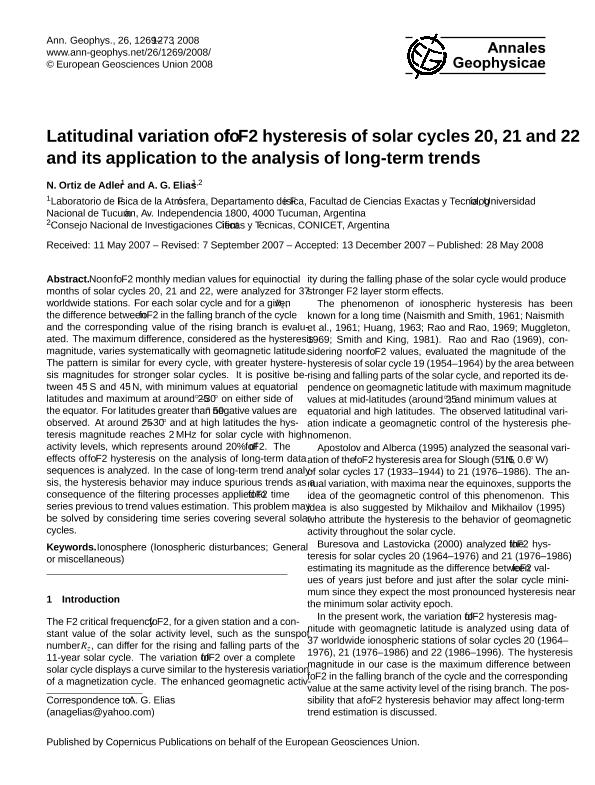Artículo
Latitudinal variation of foF2 hysteresis of solar cycles 20, 21 and 22 and its application to the analysis of long-term trends
Fecha de publicación:
12/2008
Editorial:
Copernicus Publications
Revista:
Annales Geophysicae
ISSN:
0992-7689
e-ISSN:
1432-0576
Idioma:
Inglés
Tipo de recurso:
Artículo publicado
Clasificación temática:
Resumen
F2 monthly median values for equinoctial months of solar cycles 20, 21 and 22, were analyzed for 37 worldwide stations. For each solar cycle and for a given , the difference between F2 in the falling branch of the cycle and the corresponding value of the rising branch is evaluated. The maximum difference, considered as the hysteresis magnitude, varies systematically with geomagnetic latitude. The pattern is similar for every cycle, with greater hysteresis magnitudes for stronger solar cycles. It is positive between 45S and 45N, with minimum values at equatorial latitudes and maximum at around 25-30 on either side of the equator. For latitudes greater than 50 negative values are observed. At around 25?30 and at high latitudes the hysteresis magnitude reaches 2MHz for solar cycle with high activity levels, which represents around 20% of F2. The effects of F2 hysteresis on the analysis of long-term data sequences is analyzed. In the case of long-term trend analysis, the hysteresis behavior may induce spurious trends as a consequence of the filtering processes applied to F2 time series previous to trend values estimation. This problem may be solved by considering time series covering several solar cycles. F2 monthly median values for equinoctial months of solar cycles 20, 21 and 22, were analyzed for 37 worldwide stations. For each solar cycle and for a given Rz, the difference between F2 in the falling branch of the cycle and the corresponding value of the rising branch is evaluated. The maximum difference, considered as the hysteresis magnitude, varies systematically with geomagnetic latitude. The pattern is similar for every cycle, with greater hysteresis magnitudes for stronger solar cycles. It is positive between 45S and 45N, with minimum values at equatorial latitudes and maximum at around 25?30 on either side of the equator. For latitudes greater than 50 negative values are observed. At around 25?30 and at high latitudes the hysteresis magnitude reaches 2MHz for solar cycle with high activity levels, which represents around 20% of F2. The effects of F2 hysteresis on the analysis of long-term data sequences is analyzed. In the case of long-term trend analysis, the hysteresis behavior may induce spurious trends as a consequence of the filtering processes applied to F2 time series previous to trend values estimation. This problem may be solved by considering time series covering several solar cycles.
Palabras clave:
Ionosphere
,
Solar Activity Cycle
,
Fof2
,
Hysteresis
Archivos asociados
Licencia
Identificadores
Colecciones
Articulos(CCT - NOA SUR)
Articulos de CTRO.CIENTIFICO TECNOL.CONICET - NOA SUR
Articulos de CTRO.CIENTIFICO TECNOL.CONICET - NOA SUR
Citación
Ortiz de Adler, Nieves del Carmen; Elias, Ana Georgina; Latitudinal variation of foF2 hysteresis of solar cycles 20, 21 and 22 and its application to the analysis of long-term trends; Copernicus Publications; Annales Geophysicae; 26; 5; 12-2008; 1269-1273
Compartir
Altmétricas




